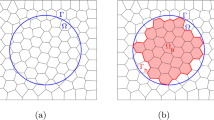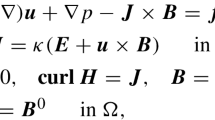Abstract
This paper presents a finite element formulation for a three dimensional nine node p-version hierarchical curved shell element for heat conduction where the element temperature approximation can be of arbitrary order p ξ, p η, and p ζ in the ξ, η and ζ directions. This is accomplished by first, constructing one dimensional hierarchical approximation functions and the corresponding nodal variable operators for each of the three directions ξ, η and ζ using Lagrange interpolating polynomials and then taking their products (sometimes also called tensor products). The element approximation functions as well as the nodal variables are hierarchical and therefore the element matrices and the equivalent heat vectors are hierarchical also i.e. the element properties corresponding to polynomial orders p ξ, p η, and p ζ are a subset of those corresponding to (p ξ+1), (p η+1), and (p ζ+1). The element formulation ensures C 0 continuity. The curved shell geometry is constructed in the usual way by taking the coordinates of the nodes lying on the middle surface of the element (ζ=0) and the nodal thickness vectors. The element properties i.e. element matrices and the equivalent heat vectors are derived using weak formulation (or quadratic functional) of the three dimensional F ourier heat conduction equation and the hierarchical element temperature approximation. The element formulation is equally effective for very thin as well as extremely thick shells. Numerical examples are presented to demonstrate the accuracy, efficiency, modeling convenience, faster rate of convergence and over all superiority of the present formulation. The h-approximation results are presented for comparison purposes.
Similar content being viewed by others
References
Ahmad, S.; Irons, B. M.; Zienkiewicz, O. C. (1970): Analysis of thick and thin shell structures by curved elements. Int. J. Numer. Methods Eng. 2, 416–451
Azevedo, J. P. S.; Wrobel, L. C. (1988): Non-linear heat conduction in composite bodies: a boundary element formulation. Int. J. Numer. Methods Eng. 26, 19–38
Babuska, I.; Zienkiewicz, O. C.; Gago, J.; Oliverira, E. R. de A. (1986): Accuracy estimates and adaptive refinements in finite element computations. New York: Wiley
Banasek, J. (1984): A conservative finite element method for heat conduction problems. Int. J. Numer. Methods Eng. 20, 2033–2050
Basu, P. K.; Lamprecht, R. M. (1979): Some trends in computerized stress analysis. Proc. 7th ASCE Conf. Electronic Comput. St. Louis, pp. 312–330
Basu, P. K.; Szabo, B. A.; Rossow, M. P. (1977): Theoretical manual and usere guide to COMET-X, an advanced computer program for stress analysis. Federal Railroad Administration. FRA/ORD-77/60
Brombolic, L. J.; Gould, P. L. (1969): Finite element analysis of shells of revolution by minimization of the potential energy functional. Proc. Symp. Appl. Finite Element Method Civil Eng. Vanderbilt University, pp. 279–307
Bruch, J. C.; Zyvoloski, G. (1974): Transient two dimensional heat conduction problems solved by the finite element method. Int. J. Numer. Methods Eng. 8, 481–494
Comini, G.; Delguidice, S.; Lewis, R. W.; Zienkiewicz, O. C. (1974): Finite element solution of nonlinear heat conduction problems with speical reference to phase change. Int. J. Numer. Methods Eng. 8, 613–624
Donea, J. (1974): On the accuracy of finite element solutions to the transient heat conduction equation. Int. J. Numer. Methods Eng. 8, 103–110
Emery, A. F.; Carson, W. W. (1971): An evaluation of the use of the finite element method in the computation of temperature. Trans. ASME J. Heat Transfer 93, 136–145
Fan, S. J.; Tsai, C. I. (1984): Finite element analysis of welding thermal behavior in transient condictions. American Society of Mechanical Engineering Technical Papers. 84-HT-80
Goldak, J.; Chakravarti, A.; Bibby, M. (1984). A new finite element model for welding heat sources. Metall. Trans. B 15B, 299–305
Kleiber, M.; Sluzalec, A., Jr. (1984): Finite element analysis of heat flow in friction welding. Rozprawy Inzynierskie. Polish Academy of Sciences, Inst. of Fundamental Technological Research, Warsaw, Poland. 32, 1, 107–113
Padovan, J. (1974a): Semi-analytical finite element procedures for conduction in anisotropic axisymmetric solids. Int. J. Numer. Methods Eng. 8, 295–310
Padovan, J. (1974b): Steady conduction of heat in linear and nonlinear fully anisotropic media by finite elements. Trans. ASME J. Heat Transfer 96, 313–318
Peano, A. G. (1975): Hierarchies of conforming finite elements. Doctoral Dissertation, Washington University, St. Louis, MO K. S. Surana and N. J. Orth: p-Version hierarchical three dimensional curved shell element
Rathjen, K. A.; Jiji, L. M. (1971): Heat conduction with melting or freezing in a corner. ASME J. Heat Transfer 93, 101–109
Surana, K. S. (1978). Theory of curved shell element. Technical Report, McDonnell Douglas Automation Company, St. Louis, MO
Surana, K. S.; Abusaleh, G. (1990): Curved shell elements for heat conduction with p-approximation in the shell thickness direction. Comput. Struct. 34, 861–880
Surana, K. S.; Kalim, P. (1985): Finite element formulation for axisymmetric shell heat conduction with temperature gradients. Presented at the Winter Annual Meeting of ASME. Miami Beach. L, pp. 17–21
Surana, K. S.; Orth, N. J. (1989): p-Approximation axisymmetric shell elements for heat conduction in laminated composites. Comput. and Struct. 33, 1251–1265
Surana, K. S.; Phillips, R. K. (1987): Three dimensional curved shell finite elements for heat conduction. Comput. Struct. 25, 775–785
Tham, L. G.; Cheung, Y. K. (1982): Numerical solution of heat conduction problems by parabolic time space element. Int. J. Numer. Methods Eng. 18, 467–474
Wilson, E. L. Nickell, R. E. (1966): Application of the finite element method to heat conduction analysis. Nucl. Eng. Des. 4, 276–286
Woo, K.-S.; Basu, P. K. (1989): Analysis of cylindrical shells by p-version of finite element method. Int. J. Solids Struct. 25, 151–165
Zienkiewicz, O. C.; Cheung, Y. K. (1965): Finite elements in the solutions of field problems. The Engineer 220, 507–510
Zienkiewicz, O. C.; Parekh, C. J. (1970): Transient field problems: two dimensional and three dimensional analysis by isoparametric finite elements. Int. J. Numer. Methods. Eng. 2, 61–71
Author information
Authors and Affiliations
Additional information
Communicated by S. N. Atluri, March 8, 1990
Rights and permissions
About this article
Cite this article
Surana, K.S., Orth, N.J. p-Version hierarchical three dimensional curved shell element for heat conduction. Computational Mechanics 7, 341–353 (1991). https://doi.org/10.1007/BF00350163
Issue Date:
DOI: https://doi.org/10.1007/BF00350163




